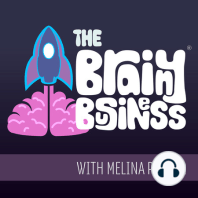47 min listen

122. Decoding the Why with Nate Andorsky, CEO of Creative Science
FromThe Brainy Business | Understanding the Psychology of Why People Buy | Behavioral Economics
122. Decoding the Why with Nate Andorsky, CEO of Creative Science
FromThe Brainy Business | Understanding the Psychology of Why People Buy | Behavioral Economics
ratings:
Length:
41 minutes
Released:
Oct 16, 2020
Format:
Podcast episode
Description
In today’s episode, I’m excited to introduce you to Nate Andorsky, CEO of Creative Science and author of Decoding the Why. Nate’s book is all about how to apply behavioral economics into consumer-facing software products and websites. It’s about experience, behavior, flow, and shares a bit about the process he and his team at Creative Science use with their clients. Decoding the Why came out in May of 2020, and as you’ll hear in our conversation today, he specializes in work with nonprofits, and also works with other organizations to help them incorporate behavioral economics to be more effective. He and his work have been featured in Forbes, Inc, The Huffington Post, Fast Company, and more. Today, we cover a bunch of ground and mention several concepts of behavioral economics that you may find yourself wanting to dig in on and learn more about (and good news...lots of links below!) Show Notes: [00:44] In today’s episode I’m excited to introduce you to Nate Andorsky, CEO of Creative Science and author of Decoding the Why. [03:10] Nate’s company, Creative Science uses behavioral science to build technology and strategies for today’s most innovative companies. [04:42] He shares a few examples of tech projects using behavioral science. [07:06] Nate really enjoys working in nonprofit social impact, consumer finance, health, and ed-tech spaces. [07:42] When working with companies they first ask, “What is the behavior we are trying to drive?” and then bring that into an awesome user experience. [09:18] If a product isn’t working exactly as a company wants, they will typically just go ask their users what they want. (Bad strategy) [10:11] There is research to suggest how we think about ourselves in the future is as a stranger—so whatever happens to that person is as inconsequential as if it were happening to a stranger. This is a big disconnect, so Nate and team look at how to close that gap. [11:52] The sooner you actually put your skill into practice, you have a better chance of learning it. [12:19] If you want to change user behavior you have to change the environment and the norms. [15:11] Nate shares about one of his favorite projects working with a medical school on their enrollment process. [15:53] You take more ownership of things if you have a hand in building it. [18:03] Nostalgia and in-group bias can help someone get social proof (which is likely to trigger the desired behaviors). [19:35] Nate wanted to be a doctor when he grew up because he comes from a family of medical professionals. During high school, he started his first business and knew he was destined to be an entrepreneur. [21:26] Melina wanted to be a singer, and shares her experience from volunteering as a company advisor with Washington Business Week. [23:12] If you want to understand the why behind something, the first thing you need to focus on is a very specific and clear problem. [23:56] Do a deep literature review, start to hypothesize, and then test what may be going on. [25:30] A really good place to test is with emails because you can measure an outcome and it is really easy to modify an email to represent a theory. [26:07] Landing pages are another great way to test. [27:46] Understanding the group can make a big difference in knowing what nudges to implement. [30:42] Melina shares about an experience where the company used existing data to help show customers something that would be beneficial to them. [32:18] If you frame things as a set, people are more likely to complete it. [34:33] Melina and Nate talk through a real-life example a listener sent in. See it and follow along in the show notes on the website! What do you think? Email Melina your thoughts... [37:13] Giving donors some insights into where their money is going can increase conversion rates. [40:42] For all the nonprofits listening if you have a project where you need more conversion (like getting and increasing donations), connect with Nate using t
Released:
Oct 16, 2020
Format:
Podcast episode
Titles in the series (100)
10. On Air Strategy Planning Session with Mariel Court: In this behavioral economics podcast it is time to apply what I have been talking about in the first 9 episodes through this very first on air strategy session, featuring my guest Mariel Court. Mariel is someone I met in the BizChix Coop (which is... by The Brainy Business | Understanding the Psychology of Why People Buy | Behavioral Economics